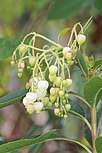Arbutus canariensis
Arbutus canariensis, known in Spanish as madroño canario, is a species of shrub or tree in the heath family. It is endemic to the Canary Islands of Spain, specifically Tenerife, La Gomera, Gran Canaria, El Hierro, and La Palma. It is threatened by habitat loss.[1]
| Arbutus canariensis | |
|---|---|
 | |
| Scientific classification | |
| Kingdom: | Plantae |
| Clade: | Tracheophytes |
| Clade: | Angiosperms |
| Clade: | Eudicots |
| Clade: | Asterids |
| Order: | Ericales |
| Family: | Ericaceae |
| Genus: | Arbutus |
| Species: | A. canariensis |
| Binomial name | |
| Arbutus canariensis Veillard ex Duhamel 1800 | |
| Synonyms[2] | |
| |
Hybrids
Arbutus x thuretiana Demoly, nothosp. nov. is a hybrid between A. canariensis and A. andrachne.[3] Named after Gustave Thuret, it is naturalised at Jardin botanique de la Villa Thuret.[4] A. x thuretiana is renowned for its perfectly smooth, reddish-brown bark, exfoliating in the spring to show a new, surprisingly pistachio-green bark, which gradually darkens and turns reddish again.[3]
Gallery
- Different parts of Arbutus canariensis and its hybrid
.jpg) Foliage
Foliage- Flowers
 Fruits
Fruits- Bark
 Flowers of the hybrid Arbutus x thuretiana
Flowers of the hybrid Arbutus x thuretiana
gollark: Ah, I simply refuse to read at arbitrary intervals.
gollark: Where *is* this blog? It doesn't seem to be incredibly obviously linked on your site.
gollark: The best way to "blog" is to use an accursed JS program to compile Markdown into static HTML.
gollark: However, as demonstrated here, the internet connection sometimes fails. I don't know if they contain very robust autoreconnect logic. Or any.
gollark: Nope!
References
- Bañares, A. et al. 1998. Arbutus canariensis. 2006 IUCN Red List of Threatened Species. Archived June 27, 2014, at the Wayback Machine Downloaded on 20 August 2007.
- The Plant List, Arbutus canariensis Duhamel
- Filippi, Olivier (2007). Pour un jardin sans arrosage (For a garden without irrigation) (in French). Arles: Actes Sud. p. 80. ISBN 978-2-7427-6730-4.
- Ducatillon, Catherine; Bellanger, Richard; Charron, Tristan; Chevallier, Joelle; Heinz, Christine; Marchal, Cecilia; Mellerin, Yannick; Caraglio, Yves; Ameglio, Thierry (2018), "Study of the adaptability of trees to drought:phenological monitoring of assisted growth sensors, in the Botanical Garden of Villa Thuret", Proceedings of the EuroGard VII Congress, EUROGARD, VII, pp. 322–331, retrieved 2020-03-23
External links
- Wildscreen Arkive
- National Arboretum Canberra (Australia), Arbutus canariensis, Canary Madrone photos and informal information
- UK Wildflowers, Arbutus canariensis, Canary Islands Strawberry Tree photos
- Useful Tropical Plants, Arbutus canariensis Images high-quality photos
| Wikimedia Commons has media related to Arbutus canariensis. |
This article is issued from Wikipedia. The text is licensed under Creative Commons - Attribution - Sharealike. Additional terms may apply for the media files.
